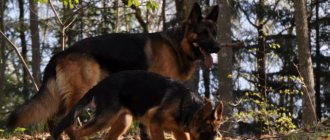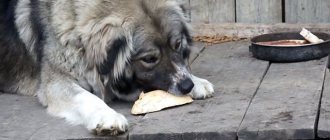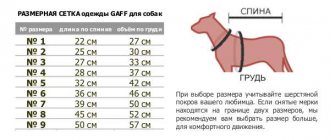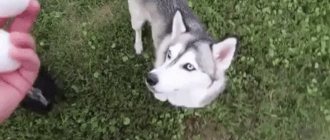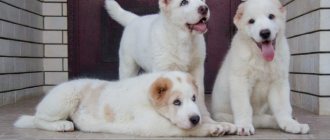One can only guess about the exact date of birth of pets taken from the street or from a shelter. When examining such animals, veterinarians only give an approximate number of years, but for owners this information is quite enough. If a visit to the veterinary clinic is temporarily impossible, then there is no need to remain in the dark while waiting for an examination. Knowing how to determine the age of a puppy or adult dog by teeth and other characteristics, you can easily cope with this task without outside help.
How to find out the age of a puppy
The most accurate diagnostic method is by looking at the teeth. All other characteristics are used as additional ones. They are necessary to clarify and reinforce the dental picture seen. A comprehensive assessment helps not to make a mistake in the age range if there are deviations from the norm: the ideal condition of the teeth or their premature loss.
Tough
Teeth remain snow-white for up to a year. Based on their appearance and quantity, the puppy’s age can be determined with a small error:
- less than 3 weeks – absence of dentition;
- 3-4 weeks – presence of primary fangs;
- 4-5 weeks – canines are complemented by incisors;
- 5-8 weeks – premolars erupt behind the canines;
- 2-4 months – the deciduous row is present entirely or is diluted with molars, large distances between the deciduous teeth are observed due to the intensive growth of the skull and jaw;
- 4-6 months – canines are added to the molars (permanent teeth are larger than milk teeth and are located close to each other);
- 6-7 months – the root row is replenished with premolars;
- 5-8 months – the number of teeth is 42 due to the appearance of 10 molars.
Another sign of a young animal is clear bumps on the enamel. As they grow older, they wear away, causing holes to appear on the surface of the tooth.
By physique and behavior
The first attempts to walk are made at 5-6 weeks. Until this time, the babies hardly move and remain close to their mother.
The active growth phase lasts for 2-4 months. Puppies study the world around them with interest, sleep less and less and play a lot. Due to changing teeth, they can chew things and become aggressive.
The most difficult period begins at puberty, that is, from six months to a year. Due to the surge in hormones, the animal does not listen well, ignores commands and shows interest in the opposite sex.
In addition to behavior, you should pay attention to physique. Young dogs have well-developed muscles and no sagging skin.
Basic principles
The principle of determining the age of a puppy or dog is based on the basic patterns of the eruption of baby teeth, their erasure, and then the appearance of permanent teeth and their erasure. Newborn puppies, of course, do not have any teeth. In older individuals, teeth wear down differently, it all depends on the diet and health of the animal. In determining the age of a dog, the incisors play the most noticeable role - each such tooth (more precisely, its crown) acts as three points (fields, teeth, points). It is important to remember that in most cases, both lateral incisors wear down over time to the point that they simply disappear.
How to find out a dog's age
By learning how to find out how old a dog is, you can give it an approximate age without any help. Despite this, veterinarians recommend using 2 more methods - ultrasound and x-ray. These studies provide the most accurate data on the state of internal organs that undergo changes as the body ages.
Tough
Age-related changes in the dentition depend on the conditions of detention, breed and other factors. When examining a dog, you need to pay attention to the thickness and color of its tooth enamel:
- 1-2 years – snow-white teeth with clear tubercles;
- 2-4 years – the first signs of darkening of the enamel, the presence of yellowness and abrasions;
- 4-6 years – the tubercles practically disappear on the incisors, tartar is present;
- 6-8 years – presence of holes and pronounced yellow color;
- 8-10 years – a large amount of tartar, severe abrasions and loss of sharpness of the fangs;
- more than 10 years – malocclusion, missing teeth.
In old age, the gums soften, leading to unsteadiness of the entire dentition. Because of this, older dogs should be fed wet canned food, cereals, minced meat and pureed vegetables.
By wool
Puppies have soft and fluffy fur. It remains silky and shiny for up to 3 years. From the age of 6-7 years, the first gray hair appears on the face, and the hairs gradually fade.
Please note that premature loss of color can be explained by stress, and deterioration in coat quality can be due to lack of proper care. Because of this, the appearance of the coat is used only for a comprehensive assessment.
By movement and activity
Adult dogs need more time to rest. When walking, they rarely run and move at an imposing pace. From the age of 8, their muscle mass decreases. The skin loses its elasticity, and a passive lifestyle quickly leads to obesity.
By the eyes
Young dogs are distinguished by a clearly defined oval of the eyes, as well as the brilliance and brightness of the iris. With aging, the eyes become cloudy, often watery and lose their usual shade.
Method No. 3. According to the condition of the coat
You can study the animal's fur. Of course, the condition of the coat is influenced by too many factors (living conditions, past illnesses, psychological state, and nutrition), but, in principle, the main age can be named.
- If the coat is soft, “fluffy”, then you have a puppy under 1 year of age.
- If the coat is “adult”, silky, shiny in appearance, then the dog is young – no more than 2-3 years.
- If there are gray hairs in the coat, there is no shine, or even the coat is not uniform, then the dog is not of a young age. And the duller the hairline, the older the age. Gray hair in the muzzle area appears at 6-7 years of age.
However, you need to understand that “bad” wool can also be the result of poor care or a serious illness. Gray hair can also appear in young individuals.
Features of different breeds
When determining a dog's age, it is important to consider its breed. Small, medium and large animals have different life expectancies, which is reflected in the speed at which they grow.
In small
Small dogs (Spitz, Chihuahua, Yorkie) are long-lived. Puberty in such pets occurs early - at six months. But teeth take a very long time to form – up to 11 months.
In the middle ones
This group includes breeds reaching 10-25 kg (Shar Peis, French bulldogs, cocker spaniels). Their puberty lasts up to 1.5 years, and molars appear by 9 months.
In large
Dogs whose weight exceeds 25 kg live shorter than all others. Despite their impressive size, they remain puppies until they are almost 2 years old. Their average lifespan is 8-10 years, so after a long growth phase, a fairly rapid aging of the body is observed.
Life expectancy and age groups
Dogs live on average from 9 to 20 years. This factor largely depends on the size of the animal. Small breed dogs usually live to older ages than their larger counterparts. Giant dogs such as mastiffs, Great Danes and St. Bernards have the shortest life cycle. There are three main groups into which all dogs can be roughly divided:
- puppy;
- young animals;
- adult representative of the species.
Technically, a dog can be considered a puppy for the first two months of its life
From the moment of birth until 8 weeks, the animal is considered to be a puppy. From this age until reaching 18 months - young animals. Dogs over this age are considered adults.
Why know a dog's age?
All veterinarians and shelter staff know how to determine the age of a dog. Determining the number of years is necessary for:
- scheduling vaccinations;
- preparation for sterilization or castration;
- safe and effective mating;
- choosing the right diet and intensity of walking.
The estimated date of birth is recorded in the dog's passport. After reaching 8 years of age, your pet’s health should be checked every six months so as not to miss the development of internal pathologies.
How long do German Shepherds live?
The average lifespan of a German Shepherd with good care is 12-13 years. Among the “Germans” there are also long-livers – 15-17 years. The main criteria for proper maintenance of a German Shepherd are a balanced diet and long-term physical activity.
The diet of a German Shepherd throughout its life should be rich in vitamins, microelements, proteins and carbohydrates. Food should be varied, and the diet should include meat, bones, cereals, vegetables, fruits, bread, vitamin and mineral supplements. It is not recommended to overfeed the animal.
Important : feeding should be done after a walk, since physical activity with a full stomach can provoke a volvulus of the stomach or intestines and lead to the death of the dog.
The German Shepherd needs a lot of physical activity - long walks, special classes, training. We must remember: for a shepherd, the meaning of life is in work , this is a service dog down to the tips of its claws.
are very important for a “German” to live a full life. This will protect your pet from epidemics and other dangerous illnesses to which German Shepherds are prone (demodex, distemper, enteritis).
Animal life stages
Throughout its life, a four-legged pet goes through several stages. Each of them is accompanied by certain changes that affect behavior and characteristics of care.
Little puppy
Until 2-2.5 months, the puppy is dependent on its mother, so it is better not to separate them during this period. Together with milk, he receives passive immunity, which protects the body until the first vaccination is given.
Complementary feeding is introduced 6 weeks after birth, and 2-4 weeks after this, four-legged babies are vaccinated against the most common infections. At 2.5 months, the puppies are taken from their mother and introduced to their new owners.
By 3-4 months the last mandatory vaccinations are given. After this, the pet can be taken outside. First he is trained to a name, place and toilet (diapers or litter tray).
The frequency of feedings gradually decreases to 3-4 times. For simplicity, it is recommended to decide on the diet in advance and stick to only one feeding option: natural or dry.
Teenager
Adolescents include sexually mature animals ready for mating. Depending on the breed, interest in the opposite sex appears at 6-8 months. Despite this, females are allowed to mate only on the third heat, and males - when they reach 1-1.5 years.
It is recommended to expand the training program from six months onwards. To do this, you will need to learn prohibition commands and other skills necessary during walks. Training can be done independently or together with a dog handler. More complex disciplines required for service dogs are best learned after 10 months.
End of growth
The active growth phase stops at 1.5-2 years. At this stage, the dog’s behavior is more difficult to correct, so professional help may be required for re-education.
Maturity
The maturity period lasts from 2 to 8 years. All this time the animals can participate in breeding. Bitches are bred no more than once a year, and males - no more than once a week. After losing their breeding value, animals are sterilized to reduce the risk of developing cancer and other diseases.
The onset of old age
After 8 years old age sets in. The pet loses its usual activity. His fur becomes dull and his teeth become loose and fall out. The portion size is reduced to avoid obesity. Vitamins necessary to maintain the cardiovascular and skeletal systems are added to the diet.
How to distinguish a breed from a crossbreed or mongrel
The surest way to purchase a purebred German Shepherd is to do so from a reliable kennel. Then the puppy will have a pedigree, a metric (puppy card), a brand with a unique number in the groin or on the ear. And you won’t have to guess whether you bought a purebred dog or not. When buying from private breeders or on the market, there is always a risk of making a mistake, because an amateur is unlikely to be able to correctly evaluate the breed. In this case, decide on the purpose: why you need a dog. To participate in exhibitions and breeding work, you need to look for a puppy only in nurseries with a good reputation. For official or security work - in the same place, because the character of a real German Shepherd, which made it a legend and a movie star, is also a sign of the breed. But then appearance is not so important, and the dog will cost much less.
The new owner signs the puppy inspection report (below) and the certificate is certified with a seal
If you want to have a companion dog with the appearance of a German Shepherd, then you can take the risk of purchasing it on the market or through “buy and sell” advertisements, but at the same time remember that a grown-up pet may unpleasantly surprise you with its difference from true “Germans”. There are signs by which you can try to distinguish a purebred puppy from a mestizo or mongrel:
- “Germans” have almond-shaped eyes with snow-white whites, while mongrel dogs have round, sometimes convex, eyes with yellowish whites or dark spots;
- an ordinary puppy cannot boast of a perfectly smooth topline and a body elongated like a torpedo;
- the tail of a small shepherd never rises above the line of the back and does not curl into a ring, like that of mongrels;
- The ears of a “German” should be floppy and soft for at least 4–5 months, while a mongrel’s ears may stand up at any time or not at all;
- A purebred baby does not have a stripe between the eyebrows (frontal furrow) on the forehead, but a purebred baby may have one;
- A shepherd puppy grows and develops much faster than a yard puppy, so at the same age he will weigh more and look more mature.
A “German” puppy is more inclined to communicate with a person than a mongrel puppy
Video: how to choose the right German Shepherd
Main features: general appearance
- The German has a wide, powerful and developed chest. Mutts often have narrow or barrel-shaped chests. The body of a purebred dog is elongated, the back is straight, the neck is long and strong. The purebred young German has a short back and lower back; on the contrary, the shoulder girdle and hips look massive.
- The paws of a purebred German Shepherd puppy are long, with well-developed muscles and certainly straight. There are no dewclaws. When moving, the front and rear paws should be flat on the surface.
- It is problematic to determine the pedigree of a small dog by appearance and color. However, let us highlight a number of special features. Puppies have a black or black and tan coat color; clear light or white spots are not allowed. It is not uncommon for babies to have a light undercoat that goes away after the first molt.
- Natural German Shepherd puppies have coats that are slightly rough to the touch. The coat of mongrel dogs is in most cases much softer.
- German leather does not form folds or sag and is elastic.
According to most dog handlers, a simple way to determine the purebred of a shepherd is through training. A purebred dog, already from the age of two months, is perfectly trainable and easily remembers commands and readily carries them out. Mongrels are less easy to train.
Understand the purpose of purchasing a pet. If you want to participate in various exhibitions and competitions, you need a purebred puppy with a good pedigree. The seller always has documents available for noble young animals. If you got a dog for your soul, by and large, thoroughbred is not important. Even if it turns out that your pet does not have a breed, you should not throw the puppy out into the street. Surround your dog with love, care and attention - and the dog will repay you handsomely.
conclusions
The age of a puppy can be determined by the developmental phase of its grin. This is difficult to do in small breeds. The age of an adult dog is determined by the degree of wear (abrasion) of the teeth. Dogs whose oral cavity has been looked after remain with a healthy grin longer. For comparison with the examination data of the animal under study, we use the dental formula.
Please follow and like us:
Nikitin Sergey
I write about dogs based on the experience and knowledge gained during my studies as a veterinarian, work in my specialty, and simply from observing my pets.
Common features
The message refers to the pet's tail. The tail of a purebred dog looks straight, saber-shaped and droops downwards. But judging by a single sign is wrong. The tail can change as it grows, you need to look at the totality of signs.
Purebred puppies often look awkward at first. By about two months, they begin to grow very quickly and gain weight, literally before our eyes. The body stretches out and gains the proportions necessary for a shepherd dog. Mutts don't grow that fast.
Who to choose - a boy or a girl
When choosing between a girl and a boy, you should focus on taste and preferences. When breeding, male dogs have stricter requirements; they are also prone to dominance, eat a lot, and if poorly trained, will mark territory throughout the house.
The bitch is more disciplined and devoted to her owner. It should be noted that a girl is more suitable for organizing a nursery, since it is on the uterine material that these organizations are formed.
Selecting a floor is an individual decision
